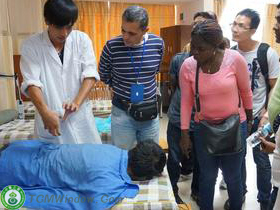TuiNa combines massage, trigger-point, and other manual techniques to stimulate acupoints, meridians, muscles and/or nerves, in order to unblock the flow of Qi.

Our clients from Mauritius are watching the performance of Chinese-style TUINA.
Tui na is a form of Chinese manipulative therapy often used in conjunction with acupuncture, moxibustion, fire cupping, Chinese herbalism, Tai chi, and qigong. It is a hands-on body treatment that uses Chinese taoist and martial art principles in an attempt to bring into balance the eight principles of Traditional Chinese Medicine. The practitioner may brush, knead, roll/press and rub the areas between each of the joints (known as the eight gates) to open the body’s defensive (wei) chi and get the energy moving in the meridians as well as the muscles. The practitioner can then use range of motion, traction, massage, with the stimulation of acupressure points; this is claimed to treat both acute and chronic musculoskeletal conditions, as well as many non-musculoskeletal conditions.
Tui na is an integral part of TCM and is taught in TCM schools as part of formal training in Oriental medicine. Many East Asian martial arts schools also teach tui na to their advanced students for the treatment and management of injury and pain due to training. As with many other traditional Chinese medical practices, there are several different schools with greater or smaller differences in their approach to the discipline. It is related also to Chinese massage. In China, Tuina is currently taught as a separate but equal field of study, with practitioners receiving the same level of training as acupuncturists and herbalists.

![Diseases, Symptoms, tcm, [tcmwindow.com]](/uploadFile/adImg/2015/4/24/6de633b8-0a7a-4546-868a-02389edf5c65.png)





